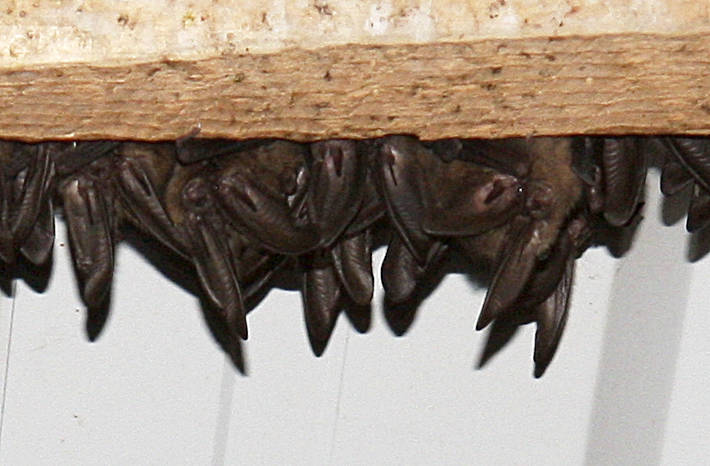by Russel Barsh
Director of KWIAHT
Kwiaht released the first annual findings of the bat grid, an array of electronic ultrasound devices that monitors nightly bat activity year-round on Lopez, Orcas and San Juan Islands. The first three recorders were activated in April 2016, one year ago. Recorders will be added as funds permit, and will help track the movements of different species of bats around the islands as the seasons change. Changes in the abundance of bat species could also be a warning of an outbreak of contagious disease.
In its first year of operation, Kwiaht’s bat grid recorded 137,345 bat flyovers, representing nine bat species. At midsummer, when island bat colonies have nearly doubled in size with pups, one recorder was logging over 600 flyovers every night.
Bats echolocate as when they are flying, as a navigational aid and to locate potential prey such as flying moths. Echolocation chirps are repetitive complex sounds, with species-specific characteristics like the songs of birds that can be used to identify species. Special software must be used to process the hundreds to thousands of chirps recorded each night, resolving them to separate flyovers or passes (like the rising and falling sound of a passing airplane), and identify them to species based on a library of verified recordings. “The technology has improved rapidly,” says Kwiaht director Russel Barsh. “Nothing like this existed 10 years ago.”
“The recorder filters out sounds outside the frequency range of our Northwest bats, and only records series of three or more successive chirps,” Barsh explains. Each record represents a bat flying over the recorder within a range of several hundred feet. “What we record is passes or flyovers. Sometimes a single bat may fly around and around near the recorder, producing several records, but we also miss bats that are coasting silently (Townsend’s Big-Eared Bats, for example, are known to do this).” Lots of background noise, including airplanes and wind, can mask chirps and make them unrecognizable.
“We are learning that many bat species congregate when they hunt, and move from night to night over the course of the peak season (April-September), presumably taking advantage of hatch-outs or swarms of different insects. One night it could be mayflies over a pond, another night midges along the seashore, and another night a termite swarm in the forest. Bats, like cats, appear to have an impeccable sense of timing and, of course, great speed and range. Bats are not territorial towards other bats, moreover, so a big swarm of insects attracts a large number of bat colonies,” Barsh explains.
The big mystery of island bats has been their winter behavior. Bat colonies in ceilings and attics mostly disperse by September each year, and bats seem to disappear from lakes and ponds that where they congregate in summer. One important finding of Kwiaht’s bat grid is that island bats remain active all winter, albeit venturing out less frequently. Colonies disperse, but only a few miles to woodlands or rocky hillside where bats spend the cold months roosting and hunting alone, for the most part. This behavior is similar to the seasonal strategy of many insectivorous birds such as Winter Wrens and Kinglets, which move to higher elevation woodlands in winter to continue feeding on winter-active insects in trees. Many moths, in particular, are winter active, and can easily be seen flying on warmer winter evenings.
Previous studies using mist nets or far smaller acoustical data sets found little consistent, statistically significant difference in bat species’ choice of habitats in the Salish Sea. Bat Grid can now explain these previous results: as the seasons change and different insects emerge and fly, bat species switch habitats as often as every night. “As an example,” Barsh says, “the rare Long-Legged Myotis congregates in large numbers around Hummel Lake on Lopez only in mid-August, and around the wetlands north of Friday Harbor only in mid-September.” Without continuous monitoring, shifts of this nature could easily be missed.
“Bats are clearly a lot more intelligent predators than we appreciate,” Barsh explains. “A bat that weighs less than a quarter can anticipate the locations of desirable insect hatches over the course of a year and relocate its night maneuvers accordingly.” Large maternity colonies of birthing bats may rely on older females (bats can live to 25 years or longer) to guide each night’s foraging trips, he speculates.
The next step, Barsh says, is to identify the insects that bats are traveling long distances from their roosts to hunt. A few recent studies elsewhere have identified traces of insect DNA in fresh bat guano, and Kwiaht has begun experimenting with this technique of fecal analysis—and using it to get Fifth and Sixth Grade students in the islands interested in genetics.
Kwiaht’s Bat Grid has been funded entirely by individual donors in the islands. Classroom projects exploring the study of insect DNA in bat guano were made possible by grants from the Satterberg Foundation, Toshiba America Foundation, and Lopez Thirft Store.




